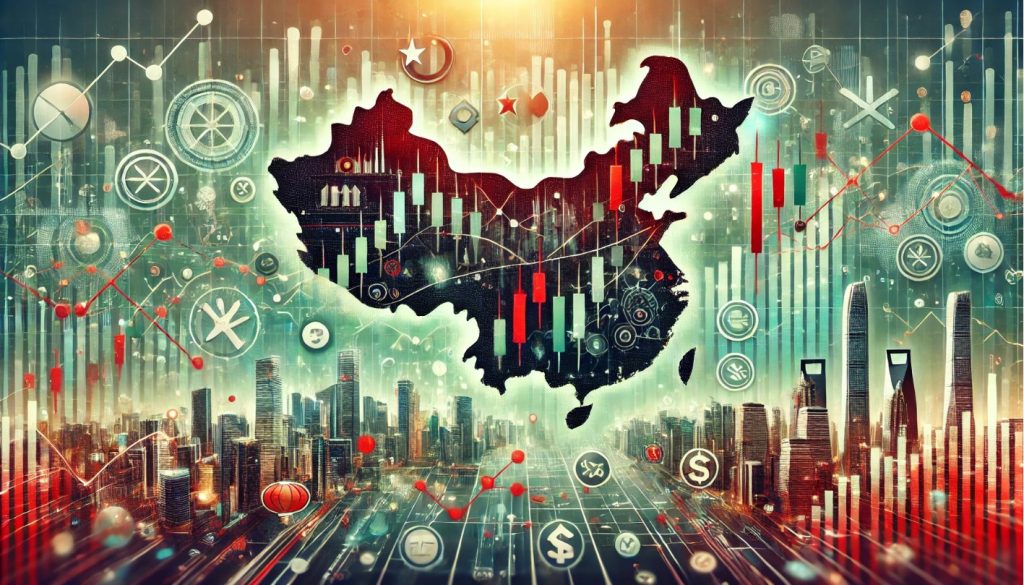China’s stock market is one of the most dynamic and rapidly growing markets in the world. As China’s economy has evolved over the past few decades, so too has its stock market. It is now one of the largest and most influential stock markets globally, attracting both domestic and international investors. The market plays a crucial role in China’s ongoing transformation from a centrally planned economy to a more market-driven economy. The Chinese stock market serves as a critical platform for capital raising, investment, and economic growth.
History and Evolution of China’s Stock Market
Early Development: Pre-Reform Era
The roots of China’s stock market date back to the early 20th century. During the Republic of China (1912-1949), Shanghai was home to China’s first stock exchange, founded in 1914. This period was marked by the flourishing of private businesses, including banks, shipping companies, and mining firms, which used stock markets to raise capital. The Shanghai Stock Exchange (SSE) played a pivotal role during this time in facilitating the economic activity of China’s major commercial centers.
However, after the establishment of the People’s Republic of China in 1949 and the rise of Mao Zedong’s Communist Party, China’s economic system became more centralized. The stock market was dismantled as private property and businesses were nationalized under the socialist economic model, and the state took control of land, resources, and capital. For nearly 40 years, China had no formal stock market. During this period, the country was focused on central planning, with the government controlling the economy through state-owned enterprises (SOEs).
Opening to Market Reforms: 1980s-1990s
The modern era of China’s stock market began after the economic reforms initiated by Deng Xiaoping in the late 1970s. With the shift toward a socialist market economy, China needed a mechanism to mobilize capital for development, attract foreign investment, and privatize its state-owned enterprises (SOEs). The government realized that a stock market would be a crucial element in this process.
The first stock exchanges were established in the early 1990s, with the Shanghai Stock Exchange reopening in 1990 and the Shenzhen Stock Exchange (SZSE) opening in 1991. These exchanges became central to China’s economic modernization. The creation of these stock exchanges was part of China’s broader reform process, which included privatizing state-owned enterprises, opening up the country to foreign investment, and building a financial infrastructure that could support a market-driven economy.
The Chinese government adopted a cautious approach to the reintroduction of the stock market, placing limits on foreign investment and introducing state-controlled regulations to protect national interests. The first companies to list on these exchanges were mainly state-owned enterprises (SOEs), which accounted for the majority of the market capitalization in the early years. These companies were essential to the economic and industrial growth of the country and became the backbone of the newly established stock market.
The Boom and Bust of the Early 2000s
The stock market experienced rapid growth and significant volatility in the early 2000s. As China’s economy boomed and the middle class expanded, so did demand for investments. In 2001, China joined the World Trade Organization (WTO), which further integrated its economy into the global financial system. This accession created opportunities for foreign investors to enter the market, opening new capital flows into the country.
China’s stock market became increasingly attractive to investors, with more companies listing on the exchanges and more foreign funds pouring in. In 2007, the Shanghai Stock Exchange saw its SSE Composite Index reach record highs, driven by investor optimism. However, this period of rapid growth was followed by a sharp correction in 2008, which wiped out much of the market’s gains. The crash was triggered by factors such as global financial instability, speculative bubbles, and government policies to control excessive borrowing.
Despite the volatility, the 2000s also marked a period of consolidation and reform. The government introduced new regulations and mechanisms to stabilize the market. These included increasing the transparency of companies, improving corporate governance standards, and introducing market reforms that encouraged foreign investments.
Recent Developments: 2010s-Present
The 2010s marked a new phase in the development of China’s stock market. China’s economy continued to grow rapidly, and the stock market began to reflect this expansion. The government introduced several reforms aimed at improving market efficiency, transparency, and foreign access. In 2014, the Stock Connect program between the Shanghai Stock Exchange and the Hong Kong Stock Exchange was launched, allowing international investors to buy and sell A-shares (shares of Chinese companies listed in mainland China) and giving Chinese investors access to foreign-listed companies.
The Star Market (科创板), launched in 2019, is another key milestone in the development of China’s stock market. Modeled after the NASDAQ in the U.S., it was created to support high-tech and innovative startups in fields like biotechnology, information technology, and artificial intelligence. The market offers more relaxed listing requirements and encourages more flexibility for younger, innovative companies.
China has also taken steps to allow greater foreign participation in its stock market. By 2020, major international index providers such as MSCI and FTSE Russell included Chinese A-shares in their indices, bringing more global capital into the market.
The stock market has become increasingly important to China’s economic strategy, helping to support the privatization of SOEs, the growth of the private sector, and the country’s ambition to become a global financial center.
Structure of China’s Stock Market
Stock Exchanges in China
The two main stock exchanges in China are the Shanghai Stock Exchange (SSE) and the Shenzhen Stock Exchange (SZSE). These exchanges are regulated by the China Securities Regulatory Commission (CSRC), which enforces the rules and regulations governing trading, market behavior, and corporate governance.
Shanghai Stock Exchange (SSE)
The Shanghai Stock Exchange is the largest and most well-established of China’s two stock exchanges. It is the home of some of China’s largest and most influential companies, particularly state-owned enterprises (SOEs) in key industries like banking, energy, and telecommunications. The SSE is also known for its emphasis on blue-chip companies and its role in facilitating large-scale IPOs.
The SSE Composite Index, which tracks the performance of all stocks listed on the exchange, is a widely followed benchmark of China’s stock market. The exchange is considered more conservative than its counterpart in Shenzhen and tends to be dominated by older, state-backed enterprises.
Shenzhen Stock Exchange (SZSE)
The Shenzhen Stock Exchange is smaller but plays a critical role in China’s financial markets. Located in the southern city of Shenzhen, the SZSE is home to many private companies, including those in technology, biotech, and consumer goods. The exchange is known for its focus on small- and mid-cap stocks, and it is particularly active in the ChiNext Board, which supports innovative and entrepreneurial companies.
The SZSE Composite Index tracks the performance of all stocks listed on the exchange. The SZSE is seen as more volatile and speculative, often attracting retail investors. Companies listed on the SZSE are generally younger and more dynamic, with a greater focus on growth than the state-owned giants on the SSE.
Star Market (科创板)
The Star Market is a new board established on the Shanghai Stock Exchange in 2019 to attract high-tech and innovative startups. Modeled after the U.S. NASDAQ, the Star Market offers easier listing requirements for companies and focuses on emerging industries like artificial intelligence, cloud computing, biotechnology, and semiconductors.
The Star Market is part of China’s broader efforts to support technology-driven growth and ensure that the country remains competitive in the global race for innovation. The market is designed to offer more flexibility and less scrutiny compared to the traditional A-share market, which helps startups with high growth potential access capital more easily.
A-shares, B-shares, and H-shares
China’s stock market is unique in that it has multiple classes of shares. These include A-shares, B-shares, and H-shares, each with different characteristics and eligibility criteria.
A-shares
A-shares are the most common class of shares in China. These shares are listed on the Shanghai and Shenzhen Stock Exchanges and are denominated in Renminbi (RMB). Initially, A-shares were only available for trading by Chinese mainland investors. However, with the advent of the Stock Connect programs, foreign investors can now access A-shares, albeit with some restrictions. A-shares are seen as the core of China’s stock market, representing both the established state-owned enterprises and high-growth private companies.
B-shares
B-shares are also listed on the Shanghai and Shenzhen Stock Exchanges, but they are denominated in foreign currencies. B-shares were created to allow foreign investors to participate in China’s stock market when the A-share market was still closed to outside capital. While B-shares were once more popular, they have lost favor over time due to the increasing liberalization of the A-share market.
H-shares
H-shares are stocks of Chinese companies that are listed on the Hong Kong Stock Exchange (HKEX) and are denominated in Hong Kong dollars. These shares are available to both domestic and international investors. Many Chinese companies choose to list their shares in Hong Kong to access global capital markets and avoid some of the regulatory constraints of mainland exchanges. H-shares are often considered more liquid and transparent than A-shares or B-shares and are favored by international investors.
Key Players in China’s Stock Market
State-Owned Enterprises (SOEs)
State-owned enterprises (SOEs) dominate the Chinese stock market, especially in the sectors of banking, energy, telecommunications, and transportation. SOEs make up a significant portion of China’s market capitalization and are viewed as vital to the country’s economic stability and growth. They are often favored by investors due to their close ties to the Chinese government and their status as “national champions.”
Examples of SOEs listed on China’s stock exchanges include China Mobile, Sinopec, and China Petroleum & Chemical Corporation. These companies are seen as relatively stable investments, but their performance can be influenced by government policies and regulatory changes.
Private Companies and Technology Firms
Over the past decade, private companies and technology firms have become increasingly important in China’s stock market. China’s technology sector has grown rapidly, with companies like Alibaba, Tencent, and Meituan emerging as global giants. These companies often list their shares on the Hong Kong Stock Exchange or the Star Market, and they are often at the forefront of China’s economic transformation.
Private companies are generally more agile and growth-oriented compared to the more established SOEs. As China’s economy shifts toward consumer-driven growth and innovation, private companies are playing a larger role in the stock market.
Institutional Investors
Institutional investors, such as mutual funds, hedge funds, and private equity firms, play a significant role in China’s stock market. These investors bring in large amounts of capital and typically invest in more mature companies, including SOEs and large private companies.
China’s stock market liberalization has also attracted foreign institutional investors, who have gained more access to the market through the Stock Connect programs and other investment channels. International investment firms, including BlackRock, Vanguard, and Goldman Sachs, now have a significant presence in China’s capital markets.
Challenges and Future Prospects
While China’s stock market has made tremendous strides in recent decades, it faces several challenges. These include issues related to market volatility, regulatory uncertainty, and corporate governance. The Chinese government plays an active role in the stock market, but the balance between state control and market dynamics remains delicate.
As China continues to open its markets to foreign investors and further develops its financial infrastructure, its stock market will likely play an even greater role in the global economy. However, the future success of the market will depend on its ability to maintain transparency, attract foreign capital, and continue evolving with the country’s economic needs.







